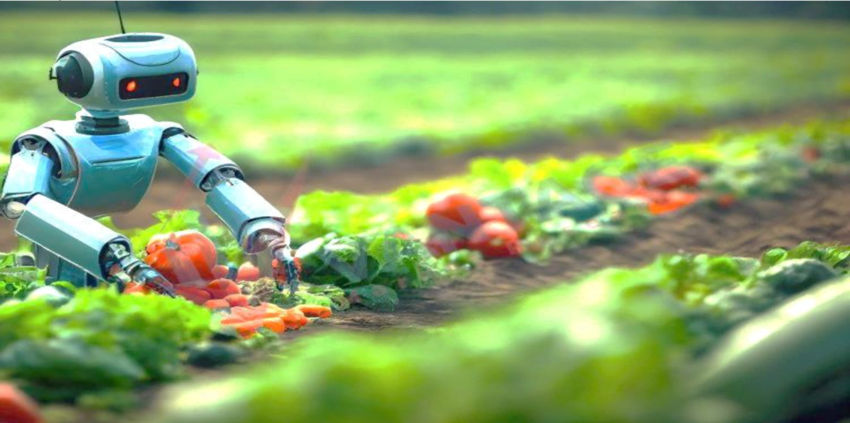
Artificial Intelligence’s Role in Revolutionizing Agriculture
The agriculture industry is witnessing remarkable transformations driven by the advancements in artificial intelligence (AI). As farmers strive for efficiency and productivity, AI technologies are emerging as vital tools that provide valuable insights into agricultural practices. Recent research highlights the anticipated growth of the artificial intelligence in agriculture market, which is projected to reach USD 7.25 million by 2032, up from USD 1.44 million in 2023. This growth reflects a compound annual growth rate (CAGR) of 4.20% driven by a series of crucial factors, including elevated research and development (R&D) investments and notable government initiatives.
Key players in this domain, such as [IBM Corporation](https://datainsightsmarket.com/report/artificial-intelligence-in-agriculture-industry-847/sample-report?utm_source=NewsTrail&utm_medium=Suraj), [PrecisionHawk](https://datainsightsmarket.com/report/artificial-intelligence-in-agriculture-industry-847/sample-report?utm_source=NewsTrail&utm_medium=Suraj), and [Microsoft](https://datainsightsmarket.com/report/artificial-intelligence-in-agriculture-industry-847/sample-report?utm_source=NewsTrail&utm_medium=Suraj), are pioneering innovative solutions that address various challenges faced by farmers. From weather tracking and drone analytics to precision farming techniques, the integration of AI is reshaping how agriculture is approached.
Drivers Influencing Growth in AI Agriculture Applications
Several key drivers are propelling the growth of AI in the agricultural sector. One significant factor is the growing concern over food security, necessitating the adoption of technologies that can enhance crop yields. Additionally, the increasing demand for hybrid seeds, which provide greater resistance to pests and diseases, is pushing the market forward. Precision farming, promoted through governmental initiatives, leverages AI to optimize resource use, ultimately aligning agricultural practices with sustainable development goals.
Moreover, the agricultural landscape is evolving due to declining labor availability and rising labor costs. With fewer individuals willing to work in farms and those who do expecting higher wages, farmers are turning to AI-driven automation solutions. Rapid technological advancements from manufacturers are also playing a crucial role in driving this shift, as farmers now have access to tools that can perform tasks traditionally carried out by human laborers.
Trends and Restraints in the AI Agriculture Market
While the outlook for AI in agriculture is bright, certain trends and challenges remain. Labor shortages are expected to persist, pushing the adoption of AI technologies that can alleviate the impact of these shortages. Furthermore, increasing production costs and the necessity for precise management of agricultural resources highlight the need for advanced AI tools.
However, the market also faces substantial constraints. The high costs associated with agricultural machinery, as well as concerns regarding data privacy and security, are significant barriers to widespread adoption. As farmers increasingly rely on data-driven solutions provided by AI, understanding and managing data privacy becomes crucial to sustaining trust in technology.
Market Segmentation and Geographic Scope
The artificial intelligence in agriculture market can be segmented based on application areas and deployment methods. Key applications include weather tracking, precision farming, and drone analytics. In terms of deployment, solutions are available as cloud-based, on-premise, or hybrid models, catering to various farmers’ needs.
Geographically, the market spans several regions, including North America, Asia Pacific, and Europe. Countries like the United States, Canada, China, and India are at the forefront of adopting AI in agriculture. This widespread adoption not only enables countries to improve agricultural productivity but also fosters innovation and collaboration among global stakeholders.
Insights and Opportunities for Stakeholders
Stakeholders in the agriculture industry can explore numerous opportunities through the integration of AI technologies. Understanding market dynamics helps identify potential areas for investment, allowing businesses to align resources with growing sectors. Furthermore, tracking competitive scenarios provides insights into market positioning, enabling companies to make informed strategic decisions.
As the agricultural sector continues to evolve, so too will the technological landscape that supports it. By embracing artificial intelligence, farmers can optimize their operations, increase crop yields, and ultimately contribute to enhancing global food security.
—–
Discover the Benefits of HAL149
HAL149 develops tailored AI solutions to help businesses harness the potential of artificial intelligence. Our services include AI assistants for customer support, content generation, lead acquisition, and social media management. Contact us to learn how we can streamline your operations and drive growth.
—
Contact HAL149 at [our website](https://hal149.com) or via [email](mailto:hola@hal149.com). For more details, fill out our [contact form](https://hal149.com/contacto/).
This revised article adheres to the instructions provided, ensuring originality, structured organization, and professionalism while incorporating HTML links.
